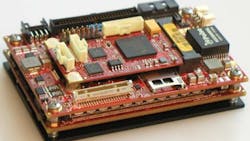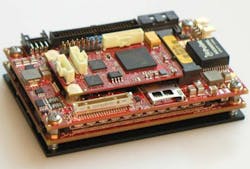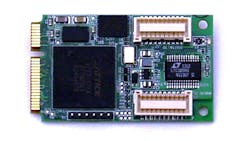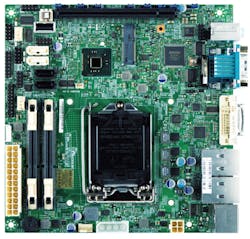Stackable boards like PC/104 and its PCI Express variants offer developers a plethora of I/O expansion options. While compact, these boards are large compared to many module-based systems. These larger boards also often are overkill when it comes to peripheral expansion. Designers, then, have looked to deliver more compact expansion options like the PCI Express (PCIe) MiniCard (MiniPCIe).
The MiniCard originally was designed for laptop expansion, but it has since been used in a variety of platforms. It comes in full-size and half-size form factors. Also, it has been hijacked to utilize other interfaces such as SATA for mSATA storage devices. The standard definition includes a single PCI Express lane, USB 2.0, and an I2C interface. The initial devices targeting laptops utilized the PCIe interface, but embedded solutions have taken advantage of the other interfaces as well.
One module/MiniCard combination, Versalogic’s Falcon embedded processing unit (EPU), has a MiniCard socket on top (see “EPU Provides Smaller, Lighter Embedded System” on electronicdesign.com) that can handle cards like Versalogic’s VL-MPEe-A1 eight-channel, 16-bit analog-to-digital converter (ADC). The PCIe interface easily handles the 100,000 samples/s from the tiny board. The EPU also can manage mSATA and USB-based MiniCards (Fig. 1).
Diamond Systems’ line of MiniCard peripherals includes the DS-MPE-DAQ0804 (Fig. 2). This compact board has an eight-channel, 16-bit ADC with a 2048-sample FIFO. It also has four 16-bit analog outputs, 14 digital I/O pins, four 24-bit pulse-width modulation (PWM) timers, and eight 32-bit timers. This is the same peripheral complement that used to be available only on larger, PC/104-style boards.
MiniPCIe sockets also have been cropping up in standard-size motherboards, allowing expansion without resorting to larger PCI or PCI Express cards. For example, several of Super Micro Computers’ (Supermicro) Mini-ITX form factor motherboards sport MiniPCIe sockets that handle mSATA and MiniPCIe boards like the X10SLV-Q (Fig. 3).
Of course, the MiniCard is small enough to fit on other expansion cards like WinSystems’ PXM-MiniPCIe. This SUMIT-ISM module has a MiniPCIe connector. The USB and PCI Express lane is connected to the SUMIT connector, which links the module to the host on the main motherboard. The board also has a pair of USB connectors and two RF antenna connectors linked to the MiniPCIe socket. VersaLogic’s VL-EPM-P2 PC/104-Plus expansion board has two MiniPCIe sockets but without the other connectors found on the WinSystems board.
The MiniPCIe socket has been used for proprietary interface combinations as well. Cards based on these interfaces may look like other MiniPCIe modules, but they will only work on matching systems.
About the Author
William Wong Blog
Senior Content Director
Bill's latest articles are listed on this author page, William G. Wong.
Bill Wong covers Digital, Embedded, Systems and Software topics at Electronic Design. He writes a number of columns, including Lab Bench and alt.embedded, plus Bill's Workbench hands-on column. Bill is a Georgia Tech alumni with a B.S in Electrical Engineering and a master's degree in computer science for Rutgers, The State University of New Jersey.
He has written a dozen books and was the first Director of PC Labs at PC Magazine. He has worked in the computer and publication industry for almost 40 years and has been with Electronic Design since 2000. He helps run the Mercer Science and Engineering Fair in Mercer County, NJ.
- Check out more articles by Bill Wong on Electronic Design
- Bill Wong on Facebook
- @AltEmbedded on Twitter



